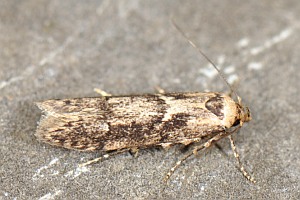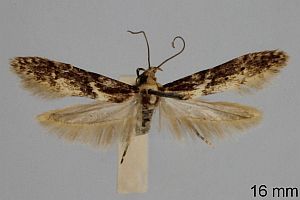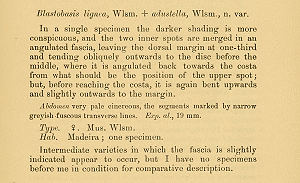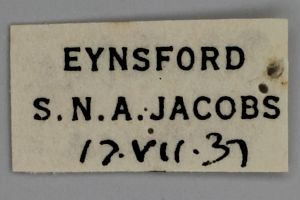

 +8Kontinente:EUOC
+8Kontinente:EUOC2. Diagnose
2.1. Geschlecht nicht bestimmt
2.2. Erstbeschreibung
3. Biologie
3.1. Nahrung der Raupe
Auf UKmoths [Artseite auf UKmoths.uk] ist zu erfahren: "The larvae feed on a variety of foodstuffs, including decaying vegetable matter". Auf Großbriannien bezogen heißt es: ": In and on soft damp Dipsacus fullonum seedheads. January. (Emmet states 873 feeds on live and decaying conifer foliage, bird droppings and other dead or live organic matter, Sept.-June)."
4. Weitere Informationen
4.1. Synonyme
- Blastobasis lignea auct.
- Blastobasis sarcophaga Meyrick, 1902
- Blastobasis xanthographella Rebel, 1940
4.2. Faunistik
Nach der [Fauna Europaea, last update 29 August 2013, version 2.6.2] kommt die aus Madeira beschriebene und schon früh nach Australien verschleppte Art mittlerweile auch in Irland, in Großbritannien, Frankreich, Belgien und den Niederlanden vor.
Auf der Seite von UKmoths [Artseite auf UKmoths.uk] ist zu England zu erfahren: "An adventitious species, this moth was introduced into Britain, and is now well established throughout. Formerly known as B. lignea, this in fact was a misidentification of 873a B. vittata, for which lignea is now a junior synonym." Die Art tritt dort mittlerweile weit verbreitet und recht häufig auf.
Howard & Goodey (2013) berichten über den Fang eines Männchens und eines Weibchens am Licht in Frankreich, Lot, Gorses.
Auf microlepidoptera.nl [Artseite auf microvlinders.nl] ist ein Nachweis für die Niederlande am Küstenbereich bei Den Helder eingetragen.
G. De Prins fing am 25. Juli 2008 ein Einzelexemplar in einer Lichtfalle in einem vorstädtischen Garten in Merksem, Provinz Antwerpen, Belgien. De Prins et al. (2009) fassen zur Verbreitung und Ausbreitungsgeschichte der Art zusammen: "B. adustella has been described from Madeira (Walsingham 1894), from where it probably was introduced unintentionally to Ireland in the beginning of the 20th century (Poulton 1928, Bond et al. 2006). It occurs there mainly in coastal areas (Anonymous 2008). Later on, it turned up in Great Britain, adventitious either from Ireland or directly from Madeira (Mansbridge 1922, Meyrick, 1928). Unfortunately, the spread of this species in Great Britain has not been measured, but it is now well established in suburban gardens throughout the country, from Wales to Scotland, with a preference for coastal areas (Agassiz 1996, Bosanquet 2008). The first record from the European continent dates from 2002 when a specimen was found at Den Helder (province of Noord-Holland, The Netherlands) on 20 July 2001, leg. K. Kaag (Huisman et al. 2004). B. adustella is adventitious in Australia already from the beginning of the 20th century (Meyrick 1928). It is widespread and often common there, especially in Queensland and New South Wales (Herbison-Evans & Crossley). The species has furthmore doubtfully been recorded from the Azores (Sinev 2007)."
Demnach ist die Art durchaus auch im Nordwesten Deutschlands zu erwarten - wohl wieder erst einmal in den küstennahen Bereichen.
(Autoren: Erwin Rennwald & Jürgen Rodeland)
4.3. Literatur
- De Prins, W., De Prins, G. & K. Larsen (2009): Blastobasis adustella (Lepidoptera: Coleophoridae, Blastobasinae), new to the Belgian list. — Phegea 37 (3): 111-118 [Digitalisat auf archive.org].
- Howard, R. & B. Goodey (2013): Blastobasis adustella Walsingham, 1894 espèce nouvelle pour la France / species new to France (Lep. Blastobasidae). — Oreina 24: 4-7. [PDF auf oreina.org]
- Erstbeschreibung: Walsingham (1894): Catalogue of the Pterophoridae, Tortricidae, and Tineidae of the Madeira Islands, with notes and descriptions of new species. — The Transactions of the Entomological Society of London for the Year 1894 (4): 535-555.













